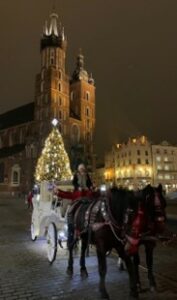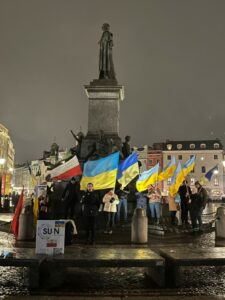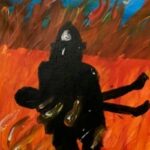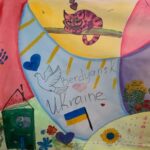Insights from our visit to Krakow, Poland
August 16, 2023
In the first week of December, my wife Karen and I were able to visit Krakow, which if you have never been to, is one of the most magical cities of Europe. This was my sixth visit to Krakow, but with the backdrop of the war in Ukraine, we were not sure what to expect. Poland has taken in 1.2 million refugees from Ukraine out of 8 million spread throughout Europe. There are likely as many inside Ukraine that have lost their homes and are in temporary shelter. What we saw in Krakow, a city that has handled the majority of the refugees as they find their way to the West is remarkable. Or should I say what we did not see is more the point. Not one refugee is on the street or in temporary camps. All of the refugees have been taken in by Polish families and provided food, shelter, medical attention, jobs, and schooling. And this is mainly funded by the people. (I couldn’t help but think to myself that in the US we have seen cities outside of the border zone receiving a few busloads of refugees and wanting to declare a state of emergency as the way to address the issue.) We met with a good friend, Thadeusz and his family, who live 45 minutes south of Krakow in the village of Zaluczne which is where my Kalec ancestry is from. The small village has taken in a family of five and provided complete care since the war started earlier this year. Most of the Ukrainians who have left their country are women and children, as all the men are expected to stay and fight unless they are over 60 years of age or disabled.
Our first night after dinner with friends Krzystof and Malgazorta, we walked past St. Mary’s Basilica in the center of the Old City of Krakow. With the Christmas tree in the center, it was a beautiful setting near the church (which is captured in a photo below.) Every hour on the hour a bugler sounds the “Hejnal mariacki” from 262 feet above which was played in the year 1241 when the Mongols attacked the city. Approximately half way through the 35 notes of the sound, the bugler abruptly stops, which signifies an arrow from the Mongol piercing the throat of the Polish bugler almost 800 years before. In more recent Krakow history, Oskar Schindler’s factory sits just off the city square and also the spot where 183 professors from the Jagellonian and other universities were rounded up by the Gestapo and sent to concentration camps. Krakow before the war was a thriving center of the Jewish population in Europe, with over 100,000 in the general vicinity of the city. Today there are 200 Jews living in Krakow. The next day we visited the JCC, the Jewish Community Center in the city and met with Jonathan and others. (Over 80% of the world’s Jewish diaspora has Polish roots.) The JCC is supporting 500 Ukrainians per day, 138,000 thus far, including over 230 tons of supplies. As 95% of the refugees are non-Jewish, Jonathan made the additional point that 80 years ago the world stood by as the Nazis killed over 6 million people. The world cannot allow history to repeat itself.
The next day we continued our walks in the city square, the home of Karol Wojtyla was a few blocks away. In 1978 he was elected Pope John Paul II. For 27 years, until his death in 2005, many people say that his number one mission was to see the end of the USSR control in Eastern Europe, and of course his home country of Poland was the center of his concern. Combined with the efforts of Lech Walesa of the Solidarity union, and millions of others in Poland, the USSR did abruptly end control in 1991. Many Polish people I have spoken with have said that the years after WWII under the USSR were worse than the atrocities suffered under Nazi Germany. Recently Pope Francis compared Stalin, Hitler, and Putin as all guilty of genocide and crimes against humanity. Let’s only hope more world leaders find their voices of condemnation with respect to the Ukraine atrocities being committed. And not only voices, but supported with actions.
What is intriguing to me is how the Polish people kept up their spirits and continued with their voices of dissent from the end of the Second World War until 1991. Because under the suppression of the Soviet Union, all dissent was met with typically a death sentence of some type. I recently listened to a semester of lectures at Yale University by the American historian Timothy Snyder. He introduced me to “Paryska Kultura” which I had not heard of before. A group of Poles and Ukrainians, mainly from Krakow and Lviv, in the late 1940s / early 1950s, after spending time in labor camps in the USSR; imprisoned in Siberia; or forced to serve in the military; eventually (somehow) found their way to Paris. These brave men and women were mainly intellectuals and citizens of influence. They began to publish a monthly booklet called the “Paryska Kultura” in Paris which was secretly distributed across Europe and smuggled into Poland. The stories were informational; tried to lift the spirits of the Polish nation, and often contained the concept of “ULB”. One of their major themes and arguments was that in order for Poland to once again become a stand-alone nation, the countries of Ukraine, Lithuania, and Belarus (acronym ULB) must once again be sovereign nations. As we all know, culture is not something that is learned overnight. I believe that the support that the Poles are providing to the Ukrainians today is embedded in a culture that goes back many generations. (A side note, Paryska Kultura was published monthly for 53 years, with the last issue in 2000.)
If interested, the lectures by Timothy Snyder are all available on YouTube. In 22 separate lectures from this fall semester, he clearly makes the case that Putin’s arguments that Kiev, Crimea, the Donbas, and the rest of Ukraine belong under the domain of Russia are 100% false. For example, Kiev was settled by the Vikings and never a part of Russia as Putin has tried to state. The fact that Snyder has been recently sanctioned twice by Russia is quite interesting in itself!
Karen and I were able to visit a refugee center in the town of Paryszka, located outside of Krakow, and only a few miles from Auschwitz. Paryszka is supporting 80 refugees with a capacity of 100. We saw mainly children, mothers and grandmothers. Most appeared to be in reasonably good spirits, but we were told that many were being provided psycho-therapy as they deal with being separated from their homes, loved ones, and all things familiar to them. They shared their lunch with us and we took a tour of the facility which is being supported 100% by the JCC out of Krakow. The children were busy drawing and coloring their thoughts on paper and two of the drawings are attached below. One is of Berdyansk and the hope that the child shares in their drawing. Berdyansk is very close to Mariupol which was a major city of close to a half million people on the Sea of Azov that has been completely destroyed. The other picture depicts a fireman carrying a child from flames of devastation. The center is being run by a very professional group of Polish supporters and many of the jobs are filled by Ukrainian refugees. They typically plan to stay 3-4 months before being resettled in some other part of Poland or Europe. They all want to return home, but the reality is that their homes no longer exist, and it may be years before they can be rebuilt.
Our last day was spent with a gentleman I have known for quite some time. His name is Zenon and he lives near the Ukraine border. He manages a tour company, but his business partner Alex, has been providing support inside of Ukraine since the war started, as far as Zhitomir, a suburb of Kiev. It takes 8 hours to cross the border into Ukraine and 17 hours to make the crossing back into Poland. Zenon has a concept which he is working on which will bring together young Ukrainian and Polish students who will learn about each other’s cultures. He plans to launch his first group of students in April of 2023, and I am excited that he has asked me to be on his advisory board.
In the evening as we walked one last time in the center square we heard singing from the direction of the Adam Mickiewicz statue. We approached the statue and there were Ukrainian and Polish people singing songs of hope in these most difficult times. They were singing “Hallelujah” at that moment in time in the cold rain and darkness. A little Ukrainian girl gave us two little bows of the blue and yellow Ukrainian colors. (Her picture is attached.) They have been present in the square since the war started back in February. It was one of the most emotional moments we have ever experienced. One of the bows is on our Christmas tree this season.
I have tried to capture the experiences from our visit and apologize if the historical background appeared to be overdone. But without understanding the history of the Polish people, it is very difficult to understand the present.





Leave a Reply
You must be logged in to post a comment.